Abstract
The “Kökyar Greening Project” in the suburb of Aksu, Xinjiang, is a model of large-area artificial afforestation in an environment of drought and water scarcity. As an important part of the “3-North Shelter Forest Program”, it plays an important role in promoting the economic development and the environmentally friendly construction of Aksu and even of the whole Xinjiang region. Based on multisource remote-sensing data and meteorological observation data, this study explored the temporal and spatial changes in the vegetation parameters (FVC, NPP, and VEQI) and the ecological parameters (RSEI and LULC) in the Kökyar Project Area from 2000 to 2021. Based on the Theil–Sen median and TSS-RESTREND, this study investigated the path of mutual influence among the FVC, NPP, VEQI, and RSEI, as well as their responses to climate change and human activities. The results show that: (1) from 2000 to 2021, the FVC, NPP, VEQI, and RSEI in the Kökyar Project Area showed a significant upward trend and showed the distribution characteristics of “high in the south and low in the north”. (2) Over the past 22 years, the RSEI has shown a significant increase with the FVC, NPP and VEQI (p < 0.001), indicating that the “Kökyar Greening Project” has achieved significant ecological benefits. (3) The changes in the vegetation parameters and RSEI in the Kökyar Project Area were dominated by human activities. (4) The Kökyar Project Area has caused great changes to the ecosystem pattern of the region, and the vegetation parameters and RSEI in the Kökyar Project Area have increased, mainly in the form of cropland and grassland expansion over the past 22 years.
1. Introduction
Vegetation plays an indicative role in global change and is an important part of Earth’s ecosystem. It also plays an important role in the process of land surface energy exchange, the biogeochemical cycle, and the hydrological cycle, and it can characterize land cover changes to a certain extent [1,2]. With the joint influence of climate change and human activities, the vegetation status in different periods will be affected, resulting in great differences in vegetation growth status between years [3,4]. Since the beginning of the 21st century, the degree of global vegetation greening has increased significantly, and China has contributed to nearly 25% of it, ranking first in the proportion of contribution [5]. This also contributes to the development of ecological governance in northwest China. The northwest is a region with the most widely distributed desertified and sandy land in China, and the continual ecological governance has led to the emergence of “green” in the region [6].
The Aksu region is located in the central and western parts of Xinjiang. It has a typical, warm-temperate arid climate, with sparse precipitation, large evaporation, and a dry climate. The desertification land area accounts for 77.08% of the total area, and the desertification land area accounts for 46.99%. It is one of the main wind-blown sand sources in southern Xinjiang [7] In order to combat the erosion of the land desertification and salinization, the Kökyar Greening Project was launched in Aksu, Xinjiang, in 1986 [8]. Over the past 36 years, cadres and the masses of all ethnic groups have worked together, and Kökyar, which was the source of sandstorms, is shaded with green trees. Additionally, taking this as the starting point, millions of acres of “green seas” have been bred in the deserts and barren beaches of southern Xinjiang [9]. Kökyar has changed from a cliff and a ravine that was once barren to a fragrant orchard with millions of acres of green trees. Aksu, which was once only 6 km away from the desert, was named the first “National Forest City” in northwest China. The United Nations also listed this green legend as one of the “Global 500 Best Places”.
However, the understanding of the improvement of the vegetation ecological quality in the Kökyar Project Area in recent decades remains qualitative, and there is a lack of temporal and spatial variation characteristics and driving mechanisms for comprehensively evaluating the vegetation ecological quality in this area from a quantitative and digital perspective. Remote sensing is currently the most powerful method with which human beings can rapidly realize global- or regional-scale Earth observation. Due to its high temporal and spatial continuity, it is considered to be one of the important means for carrying out vegetation ecological quality research [10]. To date, scholars have used remote-sensing data to create a variety of remote-sensing indices to quantify the status of vegetation ecology, such as the normalized difference vegetation index (NDVI) [11], the enhanced vegetation index (EVI) [12], net primary productivity (NPP) [13], land use and land cover (LULC) [14], and the remote-sensing ecological index (RSEI) [15].
Limited by the spatial resolution of satellite data and the small amount of single satellite data, previous studies on the changes in the temporal and spatial distribution of the vegetation ecological quality in the desert areas of Xinjiang focused on the whole area of Xinjiang or on regional-scale areas such as southern and northern Xinjiang. However, the research on small areas, particularly on the Kökyar Project Area, has rarely been conducted using high-spatial-resolution remote-sensing data. With the rapid development of space-based remote-sensing technology, great progress in spectral resolution, spatial resolution, and time resolution has been made with the use of satellite image data; this has enabled hyperspectral, high-spatial-resolution, all-time, all-weather, and real-time Earth observations. Thus, there is a large amount of macro and current data for monitoring the changes in regional vegetation ecological quality [16]. Wang et al. [17] used Landsat TM and Gaogao 1 remote-sensing images from 2005 to 2016 to monitor, analyze, and evaluate the vegetation coverage dynamics of the Aksu River Basin in Xinjiang. The results show that the vegetation coverage of the Aksu River Basin has shown a benign development trend over the past 10 years. Du et al. [18] used MODIS satellite data to analyze the temporal and spatial distribution of the vegetation NDVI and its response to climate change and human activities in Xinjiang from 1982 to 2012. Recently, Cui et al. [19] used AVHRR and MODIS NDVI data from 1989 to 2017 to analyze the temporal and spatial distribution changes in desert vegetation and the driving factors in Xinjiang. The results show that the total area of desert vegetation in Xinjiang increased significantly.
However, scholars often use single satellite data to study the vegetation quality in desertification areas based on remote sensing, and they usually take a specific ecology-related theme of the single vegetation NDVI, coverage, or vegetation NPP as guidance. This does not allow the comprehensive evaluation of the ecological status of the regional vegetation quality. The Kökyar Project Area is a model of large-scale, artificial tree planting in arid and water-deficient environments. Based on multisource satellite sensor data, it can break through the performance shackles of a single sensor, effectively give full play to the complementary observation advantages of multiple platforms, and provide refined and multi-platform remote-sensing data for the temporal and spatial characteristics of the vegetation ecological quality in the Kökyar Project Area, which is of great significance for the construction of the ecological civilization in Aksu, Xinjiang, and other regions of the country.
Using EOS/MODIS vegetation parameter products and meteorological observation data, this study explored the temporal and spatial changes in the NDVI, the fractional vegetation cover (FVC), and the NPP in the Kökyar Project Area from 2000 to 2021 and constructed a comprehensive vegetation ecological quality index (VEQI) [20] to comprehensively analyze the vegetation quality in the study area. Then, based on the Landsat series of satellite data, the random forest algorithm built into the Google Earth Engine (GEE) [21] platform was used to construct the annual LULC and RSEI of the Kökyar Project Area in order to evaluate the temporal and spatial changes in the ecological quality in the Kökyar Project Area from 2000 to 2021. Finally, based on the Theil–Sen median [22] and TSS-RESTREND [23], this study investigated the path of mutual influence among the FVC, NPP, VEQI, and RSEI in the Kökyar Project Area over the past 22 years, as well as their responses to climate change and human activities, in order to provide technical support for ecological environment protection and regional ecological environmental planning in the study area in the future.
2. Study Area and Data
2.1. Study Area
Kökyar is located in the northeast of Aksu, Xinjiang, close to the suburbs of Aksu City. The desert area in the east is the main birthplace of the Aksu sandstorm. The Kökyar Project Area starts from Wensu County under the Tomur Peak of Tianshan Mountain in the north; it spans the urban area of Aksu City and connects with the Tuanchang of Alar City on the edge of the Taklimakan Desert in the south (Figure 1). It is a desert with vertical and horizontal gullies and sparse vegetation in the alluvial platform between the Aksu River and the Tailan River at the southern foot of Tianshan Mountain. It is commonly known as “Kapo”, which is located in Aksu and the northeast suburb of Wensu County on the northern edge of the Taklimakan Desert (known as the “Sea of Death”) [24].

Figure 1.
Sketch map of the research area.
2.2. Data
Multisource remote-sensing data were used in this study, including the precipitation (PRE) [25], temperature (TEMP) [25], the NDVI [26], the digital elevation model (DEM) [27] and Landsat 5/6/7 [28]. The data used in this study are detailed in Table 1.

Table 1.
Detailed description of the data.
3. Methods
The methods of this work are divided into six parts: (1) the estimation of the annual NPP based on the terrestrial ecosystem carbon flux (TEC) [29]; (2) the estimation of the annual FVC based on the pixel dichotomy; (3) the estimation of the annual vegetation quality index based on the VEQI model; (4) the estimation of the annual ecological quality index based on the RSEI model; (5) the construction of the annual LULC products based on the random forest model; and (6) the performance of the driving analysis of the vegetation parameters (FVC, NPP, VEQI, and RSEI).
3.1. Estimation of Net Primary Productivity
Based on the MODIS NDVI monthly synthetic products and meteorological observation data during the same period, this study used the TEC flux model provided by the National Meteorological Center to estimate the vegetation NPP of the Kökyar Project Area. The spatial resolution of the NPP in this study was 1000 m, and the temporal units are annual (sum of monthly data).
where Ra is the assimilation product consumed by the respiration of the trophoblast, expressed as:
where Ta is the monthly average temperature.
In the TEC, the GPP is calculated using:
where is the maximum rate of light energy utilization, is the temperature stress factor, is the water stress factor, and FPAR is the ratio of the photosynthetic effective radiation absorbed by vegetation photosynthesis.
3.2. Estimation of Fractional Vegetation Cover
The FVC refers to the percentage of the vertical projection of the vegetation canopy in the cross-sectional area of the statistical area. It is an important index for measuring the regional ecological environment [30]. This study calculated the FVC according to the pixel dichotomy method. The spatial resolution of the FVC in this study was 1000 m and the temporal unit was ‘annual’ (the mean of the monthly data).
where the NDVIsoil represents the value at which the pixel is pure bare soil, and the NDVIveg represents the value at which the pixel is pure vegetation. According to the characteristics of the vegetation in China, the NDVIsoil and the NDVIveg in this study were 0.05 and 0.95, respectively.
3.3. Estimation of VEQI
The VEQI is a parameter that comprehensively reflects the vegetation ecological quality by considering the importance of the FVC and NPP to the vegetation ecological quality in a certain area and using the weighting method. The spatial resolution of the VEQI in this study was 1000 m, and the temporal unit was annual. The VEQI can be expressed as:
where f1 and f2 represent the weight coefficients of the FVC and NPP, respectively. In this study, f1 = f2 = 0.5; the NPPmax represents the maximum value of the vegetation NPP in this period, i.e., the land NPP under the best local meteorological conditions. The value of the VEQI is between 0 and 100.
3.4. Estimation of RSEI
The RSEI has been widely used in regional eco-environmental quality assessment since it was proposed by Xu et al. The RSEI consists of the greenness index (NDVI), the humidity index (WET), the heat index (LST), and the dryness index (NDBSI). The selected indicators were completely based on remote-sensing information, which was easy to obtain. The calculation process does not need manual intervention, and the results are objective and reliable [31,32]. The spatial resolution of the RSEI in this study was 30 m, and the temporal unit was annual. The RESI can be expressed as:
where PC1 is the first principal component, NDVI is the normalized difference vegetation index, NDBSI is the dryness index, SI is the soil index, IBI is the improved building index, WETOLI is the humidity index calculated by the OLI sensor, and WETTM is the humidity index calculated by the TM sensor.
It should be noted that the land surface temperature (LST) index was calculated using the open-source code (the SMW algorithm) [33], provided by Ermida et al. in the Google Earth Engine (GEE).
3.5. Land Use and Land Cover Classification
In this study, the Landsat 5/7/8 surface reflectance data provided by the GEE platform were processed by cloud removal, terrain correction [34], BRDF correction [35], etc., and the LULC of the Kökyar Project Area was classified based on the random forest model. First, we used the QA quality assessment band generated by the Cfmask model to mask the cloud pixels in the data and to eliminate the impact of cloud on the LULC classification. Second, we applied the well-performing Sun Canopy Sensor + C correction model to each scene to avoid the problematic under- or overcorrection observed in the steep slopes. Third, we normalized the reflectance values using the nadir bidirectional reflectance distribution function (BRDF) correction to obtain seamless mosaics. In order to improve the classification accuracy, this study selected the NDVI, NDWI, NDBI, BAEI, NDBai, DBI, DBSI, and TPI as the characteristic variables of the random forest model (Table 2) [36]. Based on the surface characteristics of the study area, this study finally selected five land types, namely cropland, grassland, water, bare land, and built-up area. The spatial resolution of the LULC in this study was 30 m, and the temporal unit was annual.

Table 2.
Detailed descriptions of names, formulas and references for indices.
3.6. Driving Analysis
3.6.1. Theil–Sen Median
Based on the Theil–Sen median [22] and TSS-RESTREND [23], this study explored the path of mutual influence among the FVC, NPP, VEQI, and RSEI in the Kökyar Project Area over the past 22 years, as well as their responses to climate change and human activities.
The Theil–Sen median is a robust nonparametric statistical trend calculation method, which has high computational efficiency and insensitivity to measurement errors and outlier data. This method is often used in the trend analysis of long-term series data. This study used the Theil–Sen median to analyze the changing trends of the FVC, NPP, VEQI, and RSEI at the pixel scale.
where β is the changing trend of the index, Vegj is the index value in the jth year, and Vegi is the index value in the ith year.
3.6.2. TSS-RESTREND
Climate change (e.g., precipitation and temperature) and human activities are important factors affecting the interannual changes in the vegetation ecological parameters (FVC, NPP, VEQI and RSEI) [44,45]. This study used the TSS-RESTREND to explore the effects of climate factors and human activities on the vegetation parameters. The method included three steps: (1) by using the temperature and precipitation data as independent variables and the vegetation ecological parameters as dependent variables, a multiple linear regression model was established. (2) Based on the fitting regression model and the temperature and precipitation data, the vegetation ecological parameters were calculated. The simulated value of the parameter (VegCC) was used to represent the impact of the climate factors on the vegetation ecological parameters. (3) The vegetation ecological parameter residual (VegHA), i.e., the difference between the true value of the vegetation ecological parameters and the simulated value, was used to represent the impact of human activities on the vegetation ecological parameters (Table 3). The calculation formulae are as follows:
where VegCC is the simulation value of the vegetation ecological parameters (FVC, NPP, VEQI, and RSEI) under the influence of precipitation and temperature; T and P are the temperature and precipitation, respectively; a, b, and c are the fitting coefficients; VegHA is the residual; and VegOBS is the vegetation parameters calculated from the remote-sensing data.

Table 3.
Determination criteria for driving factors of changes in vegetation ecological parameters and calculation method for contribution rate.
4. Results
4.1. Temporal and Spatial Changes
4.1.1. FVC
The FVC is an indicator factor characterizing the vegetation growth state and can reflect the size of the photosynthetic area of plants and the lush degree of vegetation growth. Based on the 16-day vegetation index product of the EOS/MODIS satellite from 2000 to 2021, this study used the pixel dichotomy method to calculate the FVC and then used the maximum synthesis method to obtain the monthly and annual FVC. The temporal variation trend and the spatial distribution characteristics of the FVC in the Kökyar Project Area were discussed.
The FVC in the Kökyar Project Area presented the distribution characteristics of “high in the south and low in the north” (Figure 2a). Additionally, from 2000 to 2021, the FVC increased significantly (Figure 2b), with an annual average increase of about 1.09, and the “greening” in the northern part of the Kökyar Project Area was obvious (Figure 2a). The FVC in 2021 reached the highest value over the years (46.60), with an increase of 107.11% compared with that in 2000 (22.50). This shows that over the past 22 years, the “Kökyar Greening Project” has brought huge ecological benefits to the area. However, the northern border area of the study area remains in a desertification situation, i.e., the phase D area of the project (Figure 1), indicating that the “Kökyar Greening Project” still needs to be further implemented.
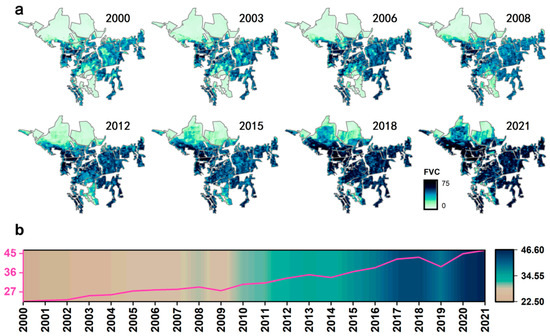
Figure 2.
Spatiotemporal changes in FVC in Kökyar Project Area from 2000 to 2021. (a) Spatial distribution map of FVC in Kökyar Project Area from 2000 to 2021. (b) Time-series changes in FVC in the Kökyar Project Area from 2000 to 2021.
4.1.2. NPP
The NPP refers to the remainder after deducting the autotrophic respiration from the total organic dry matter produced by the photosynthesis of green plants per unit time and unit area. As a key variable for characterizing vegetation vitality, the NPP is the basis of the energy and material circulation of both the organisms and the ecosystem and is related to the ecosystem’s ability to fix carbon. The TEC model provided by the National Meteorological Center was used to calculate and synthesize the monthly and annual NPP and thus to analyze the temporal variation trend and spatial distribution characteristics of the NPP in the Kökyar Project Area.
The NPP in the Kökyar Project Area presented the distribution characteristics of “high in the south and low in the north” (Figure 3a), which is consistent with the spatial distribution characteristics of the FVC (Figure 2a). Additionally, from 2000 to 2021, the annual NPP in the Kökyar Project Area showed a gradual upward trend (Figure 3b), with an average annual increase of about 1.34 gC/m2. In addition, the “greening” in the north of the Kökyar Project Area was obvious (Figure 3a). In 2013, the average NPP in the whole region was the highest, 108.95 gC/m2. The lowest NPP was in 2009 (27.65 gC/m2). In 2021, the average NPP in the whole region was 62.20 gC/m2, showing an increase of 90.39% compared with that in 2000 (32.67 gC/m2).
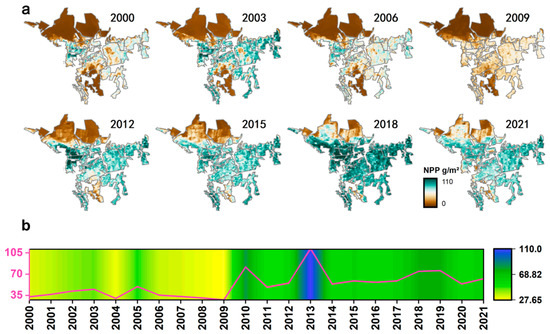
Figure 3.
Spatiotemporal changes in NPP in Kökyar Project Area from 2000 to 2021. (a) Spatial distribution map of FVC in Kökyar Project Area from 2000 to 2021. (b) Time-series changes in NPP in the Kökyar Project Area from 2000 to 2021.
4.1.3. VEQI
The NPP and the FVC are the two most basic characteristic quantities reflecting the service function of the terrestrial ecosystem and the ecological quality of the vegetation. However, using the NPP or the FVC alone can only reflect one aspect of the terrestrial ecosystem service function or the vegetation ecological quality, i.e., the production capacity or the coverage capacity. Based on the NPP and the FVC, the constructed VEQI can reflect the comprehensive ability of the vegetation production capacity and the coverage capacity per unit area and can solve the spatial problems of the same NPP per unit area but a different FVC for the ground, or the same FVC but a different NPP. Therefore, based on the monthly and annual FVC and NPP, this paper constructed the VEQI. The VEQI can reflect both the vegetation productivity and the coverage.
As with the changing trend of the FVC and the NPP, the changing trend of the interannual VEQI in the Kökyar Project Area from 2000 to 2021 (Figure 4a) in the whole region also presented the distribution characteristics of “high in the south and low in the north” (Figure 4a). Over the past 22 years, the interannual VEQI has increased steadily (Figure 4b), with an annual average increase of about 0.68, and the VEQI in the north of the Kökyar Project Area showed the most significant increase (Figure 4a). In 2021, the VEQI in the whole region reached the highest value of the past 22 years, i.e., 26.92. Additionally, the VEQI of 2000 was the lowest over the years, i.e., 11.98. From 2000 to 2021, the VEQI in the whole region increased by 61%.
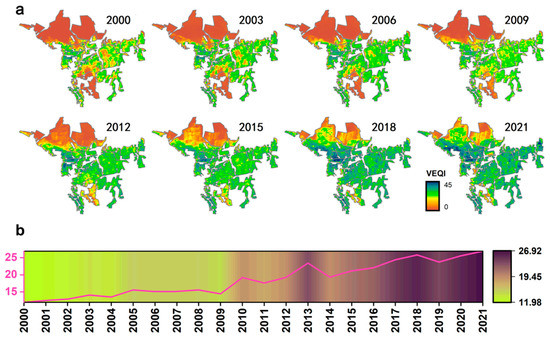
Figure 4.
Spatiotemporal changes in VEQI in Kökyar Project Area from 2000 to 2021. (a) Spatial distribution map of FVC in Kökyar Project Area from 2000 to 2021. (b) Time-series changes in VEQI in the Kökyar Project Area from 2000 to 2021.
4.1.4. Remote-Sensing Ecological Index
In order to quantify the environmental benefits brought by the “Kökyar Greening Project” to the region over the past 22 years, this study selected four important indicators closely related to the land-surface ecological environment, i.e., greenness, humidity, heat, and dryness. The remote-sensing ecological index (RSEI) data of the Kökyar region for the past 22 years were calculated.
The spatial change trend of the RSEI in the Kökyar Project Area was consistent with that in the project construction phase (Figure 1). In 2000, the high-RSEI areas were basically in the middle and east of the project area, i.e., the construction areas of the Phase A, B, and C projects, and the north and south of the project area were low-RSEI areas. Over the past 22 years, after the construction of the Phase D, the low-value areas of the RSEI in the north and south of the project area have been significantly improved, which is mainly reflected in the gradual reduction in the area of the low-value areas of the RSEI and the significant increase in the medium- and high-value areas in the north and south (Figure 5a). In 2000, the area above the good level of the RSEI (>0.6) was 44.86 km2, accounting for about 39% of the total area of the project area. In 2021, the area above the level of the good level was 66.04 km2, accounting for about 58% of the total area of the project area. In 2021, the area above the good level of the RSEI increased by 21.18 km2 compared with that in 2000, and the effect of desertification control was remarkable.
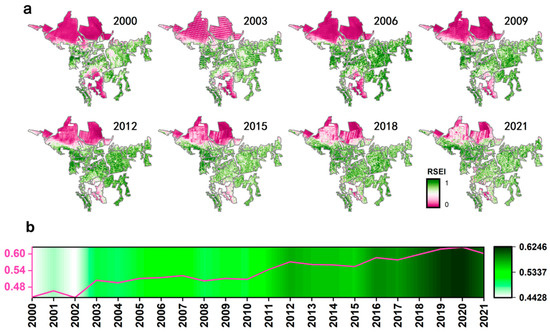
Figure 5.
Spatiotemporal changes in RSEI in Kökyar Project Area from 2000 to 2021. (a) Spatial distribution map of FVC in Kökyar Project Area from 2000 to 2021. (b) Time-series changes in RSEI in the Kökyar Project Area from 2000 to 2021.
As shown in Figure 5b, from 2000 to 2021, the mean value of the RSEI in the project area showed a significant upward trend on an interannual scale, with an average increase of 0.02 every 10 years. The multi-year average RSEI was 0.53, indicating that the total ecological quality in the project area was at a medium, close-to-good level. In 2020, the RSEI reached the highest value, 0.62, and the RSEI was at a good level, with an increase of 41% compared with that in 2000 (0.44). It shows that the “Kökyar Greening Project” has greatly improved the ecological quality of the area over the past 22 years.
4.2. Driving Analysis
4.2.1. Regional Scale
In this study, the scatter map of the annual-scale of the RSEI and the FVC, NPP, and VEQI was drawn (Figure 6). It can be seen from the figure that, from 2000 to 2021, the Pearson correlation coefficients (PCCs) of the FVC, VEQI, and RSEI were greater than 0.92, while the PCCs of the NPP and RSEI were lower (only 0.557). However, over the past 22 years, the RSEI has shown a significant increase with the FVC, NPP, and VEQI (p < 0.001), indicating that the “Kökyar Greening Project” has achieved significant ecological and environmental benefits.
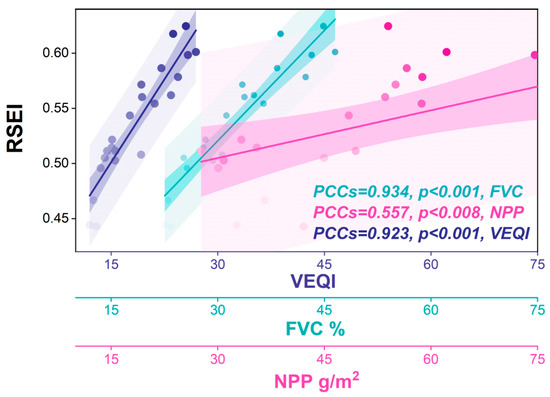
Figure 6.
Scatter map of the annual-scale RSEI, FVC, NPP, and VEQI.
4.2.2. Pixel Scale
Theil–Sen Median
In this study, the Theil–Sen median was used to calculate the interannual trend of the annual data of the RSEI, FVC, NPP, and VEQI. Then, 13,000 sample points were randomly selected in the study area, and the trend value of each index was extracted. Finally, they were linearly fitted in pairs (Figure 7).
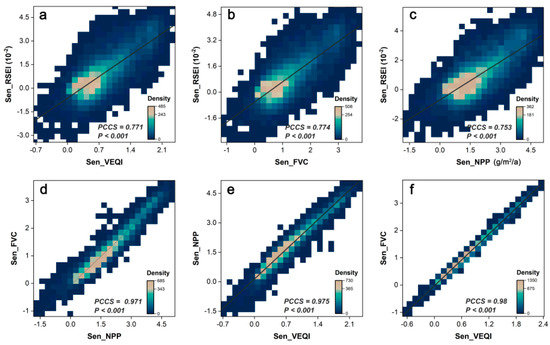
Figure 7.
Pixel-scale spatial variation of temporal trends. (a) Scatter fit of RSEI trend and VEQI trend. (b) Scatter fit of RSEI trend and FVC trend. (c) Scatter fit of RSEI trend and NPP trend. (d) Scatter fit of FVC trend and NPP trend. (e) Scatter fit of NPP trend and VEQI trend. (f) Scatter fit of FVC trend and VEQI trend.
It can be seen from Figure 7 that the PCCs between the NPP, FVC, and VEQI were greater than 0.95 (Figure 7d–f), indicating that these three indicators had a very significant positive correlation in the time-series changes. The PCCs between the RSEI and the three indices were low, but larger than 0.75, and all passed the significance test (Figure 7a–c). Secondly, among the three indicators, the PCC between the FVC and the RSEI was the highest (0.774) (Figure 7b), while the PCC between the NPP and the RSEI was the lowest (0.753) (Figure 7c), which is consistent with the conclusion drawn in Section 4.2.1. This shows that the correlation between the RSEI and the NPP, FVC, and VEQI is consistent at the panel and pixel scales.
TSS-RESTREND
As can be seen from Figure 8, the FVC, NPP, VEQI, and RSEI in most areas of the Kökyar Project Area showed a significant upward trend from 2000 to 2021. Additionally, the changing trend of these vegetation parameters and the RSEI driven by human activities (residual trend) was highly consistent with the spatial distribution of the corresponding actual trend. This indicates that human activities were the dominant factor in the change in the vegetation parameters and the RSEI in the project area from 2000 to 2021. Secondly, the changing trend of the vegetation parameters and the RSEI driven by climate factors was relatively weak, indicating that the vegetation parameters and the RSEI in most areas were less affected by climate. From the spatial distribution map of human activity contribution and climate change contribution in Figure 9, it can be seen that over the past 22 years, human activities have been the dominant factor in the changes in the vegetation parameters and the RSEI in the Kökyar Project Area.
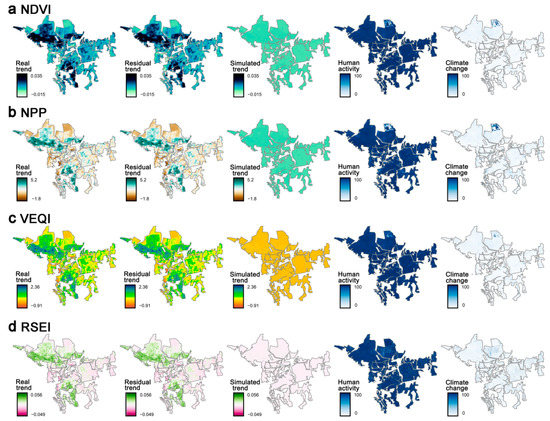
Figure 8.
The scatter map of the annual-scale RSEI and FVC, NPP, and VEQI.
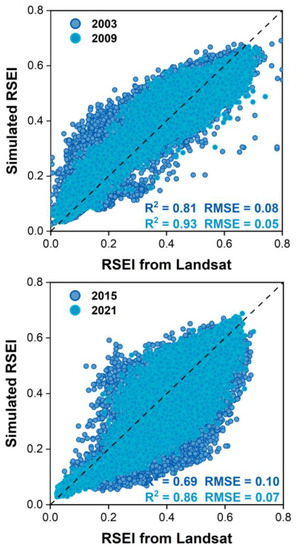
Figure 9.
Scatter fitting diagram of the RSEI simulated by TEE-RESTREND and the RSEI retrieved by Landsat (2003, 2009, 2015, and 2021).
Applicability of TEE-RESTREND
In order to explore the applicability of the TEE-RESTREND in the study area, this study took the RSEIs in 2003, 2009, 2015, and 2021 as examples to compare the simulated RSEI from TEE-RESTREND with the RSEI from the Landsat image (Figure 9). Figure 10 shows that the simulated RSEI had a high overall correlation with the actual RSEI (p < 0.001, R2 > 0.65 and RMSE ≤ 0.1. However, it was also found that the fitting effect of the different years was different. For example, the R2 values of 2003, 2009, and 2021 were all greater than 0.8, and the RMSE was less than 0.1.
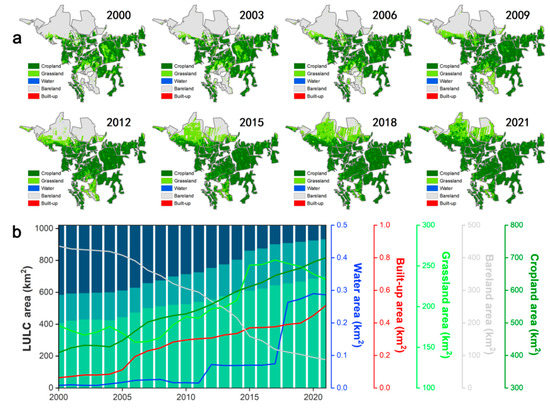
Figure 10.
LULC distribution map of the Kökyar Project Area (a) and long-term series of areas of various land types (b).
4.3. Spatiotemporal Evolution of LULC
In order to explore the impact of the “Kökyar Greening Project” on the regional ecosystem pattern, this study used the random forest algorithm and 2432 Landsat images to invert the LULC data of the Kökyar Project Area from 2000 to 2021. Table 4 shows that the LULC data have good accuracy.

Table 4.
Accuracy verification of LULC data.
As can be seen in Figure 10a, over the past 22 years the types of land cover in the study area have mainly been cropland, grassland, and bare land. The bare land was mainly distributed in the southern and northern areas, which belong to the Phase D area of the project area. The grassland and cropland were mainly in the central region. Over the past 22 years, the area of bare land has shown an annually downward trend, while the other four types have shown an overall upward trend. Among them, the area of bare land decreased by 348.83 km2 from 2000 (435.64 km2) to 2021 (86.81 km2). The area of cropland increased the most, from 408.85 km2 in 2000 to 700.26 km2 in 2021, with an increase of 291.41 km2; the area of grassland type increased by 56.71 km2. The water and built-up areas in the Kökyar area slightly increased. This shows that over the past 22 years, the Kökyar Project Area has brought great changes to the ecosystem pattern of the region, and the vegetation parameters (FVC, NPP, and VEQI) and the RSEI have mainly increased in the form of cropland and grassland expansion.
5. Limitations
From the section on the Applicability of TEE-RESTREND, it was found that the fitting effect varied greatly in the different years. This phenomenon can be explained according to two aspects. Firstly, the rationality of the meteorological data interpolation method needs to be further demonstrated. Secondly, only using temperature and precipitation to quantify climate change increases the uncertainty of the study. In fact, in addition to temperature and precipitation, other climatic factors also affect the vegetation ecological status, such as the vapor pressure deficit (VPD) [46,47], atmospheric pressure [48,49], shortwave radiation [50,51], and wind speed [52,53]. However, in the current state, it is still unrealistic to thoroughly reveal the driving mechanism of the vegetation ecological parameters of Kökyar. In the future, based on this study, we will continue to explore this subject in depth and clarify the evolution mechanism of the vegetation ecological parameters in the Kökyar region in order to provide strong data support for the effective implementation of ecological restoration projects in this region.
6. Conclusions
After the national project of returning grazing land to grassland was launched in 2002, with the strong support of the state and the autonomous region, the Aksu prefectural party committee actively implemented the ecological restoration and treatment project, vigorously promoted the construction of ecological civilization under the guidance of the “two mountains” theory, and conceived an innovative method with Aksu characteristics, ecological priority, and green development. Specifically, the “Kökyar Greening Project” was implemented. Since the active planting of fruit trees, the annual income of the local people has increased significantly. This not only drives local economic development but also protects the ecological environment [9]. Based on multisource remote-sensing data and meteorological observation data, this study analyzed the temporal and spatial changes in the vegetation and ecosystem parameters, such as the FVC, NPP, VEQI, RSEI, and LULC, in the growing season from 2000 to 2021 in the Aksu Kökyar Project Area and the driving factors. The results show that:
- (1)
- From 2000 to 2021, the FVC, NPP, VEQI, and RSEI in the Kökyar Project Area showed a significant upward trend and the spatial distribution characteristics of “high in the south and low in the north”. Over the past 22 years, the average annual increase in the FVC has been about 1.09, with an increase of nearly 107.11% compared with that in 2000. The average annual growth of the NPP was about 1.34 gC/m2, which was 90.39% higher than that in 2000 (32.67 gC/m2). On average, the RSEI has increased by 0.02 every 10 years.
- (2)
- Over the past 22 years, the ecological quality has been significantly promoted according to the FVC, NPP, and VEQI (p < 0.001), indicating that the “Kökyar Greening Project” has achieved significant ecological and environmental benefits.
- (3)
- From 2000 to 2021, the changes in the vegetation parameters and ecological quality in the Kökyar Project Area were dominated by human activities.
- (4)
- Over the past 22 years, the Kökyar Project Area has brought great changes to the ecosystem pattern of the region. The bare land was reduced in a large area (348.83 km2), while the cropland (291.41 km2) and grassland (56.71 km2) showed a significant growth trend, indicating that the vegetation parameters (FVC, NPP, and VEQI) and the RSEI in the Kökyar Project Area have increased mainly in the form of cropland and grassland expansion.
- (5)
- This study used a variety of vegetation ecological parameters to comprehensively demonstrate the ecological and environmental effects of the greening projects in the Kökyar area over more than 20 years, with different scales, methods, and models. It can provide strong data support for ecological environmental protection in this region.
Author Contributions
Conceptualization, Z.W.; Funding acquisition, H.F.; Investigation, J.S.; Methodology, Z.Z.; Project administration, C.N.; Resources, J.K.; Software, P.Y.; Validation, D.W.; Writing—original draft, T.B.; Writing—review & editing, D.X. All authors have read and agreed to the published version of the manuscript.
Funding
This research was funded by the Zhejiang Meteorological Science and Technology Plan Project (2021YB07), the Natural Science Foundation of Zhejiang Province (LQ21D060001), the Fengyun Satellite Advance Plan (FY-APP-2021.0105), the Special Program for Innovation and Development of China Meteorological Administration (CXFZ2022J040), the Research on Meteorological Disaster Assessment Technology of Policy Agricultural Insurance in Aksu Area (YD202224), and the Meteorological science and technology project of Aksu Meteorological Bureau (AKS202209, AKS202206).
Institutional Review Board Statement
Not applicable.
Informed Consent Statement
Not applicable.
Data Availability Statement
Data sharing is not applicable to this article.
Acknowledgments
This research was funded by the Zhejiang Meteorological Science and Technology Plan Project (2021YB07), the Natural Science Foundation of Zhejiang Province (LQ21D060001), the Fengyun Satellite Advance Plan (FY-APP-2021.0105), the Special Program for Innovation and Development of China Meteorological Administration (CXFZ2022J040), the Research on Meteorological Disaster Assessment Technology of Policy Agricultural Insurance in Aksu Area (YD202224), and the Meteorological science and technology project of Aksu Meteorological Bureau (AKS202209, AKS202206).
Conflicts of Interest
The authors declare no conflict of interest.
Abbreviations
| FVC | fractional vegetation cover |
| NPP | net primary productivity |
| VEQI | vegetation ecological quality index |
| RSEI | remote-sensing ecological index |
| TEC | terrestrial ecosystem carbon |
| LULC | land use and land cover |
References
- Foley, J.A.; Prentice, I.C.; Ramankutty, N.; Levis, S.; Pollard, D.; Sitch, S.; Haxeltine, A. An integrated biosphere model of land surface processes, terrestrial carbon balance, and vegetation dynamics. Glob. Biogeochem. Cycles 1996, 10, 603–628. [Google Scholar] [CrossRef]
- Cowling, S.A.; Field, C.B. Environmental control of leaf area production: Implications for vegetation and land-surface modeling. Glob. Biogeochem. Cycles 2003, 17, 7-1–7-14. [Google Scholar] [CrossRef]
- Herrmann, S.M.; Anyamba, A.; Tucker, C.J. Recent trends in vegetation dynamics in the African Sahel and their relationship to climate. Glob. Environ. Chang. 2005, 15, 394–404. [Google Scholar] [CrossRef]
- Huang, S.; Zheng, X.; Ma, L.; Wang, H.; Huang, Q.; Leng, G.; Meng, E.; Guo, E. Quantitative contriution of climate change and human activities to vegetation cover variations based on GA-SVM model. J. Hydrol. 2020, 584, 124687. [Google Scholar] [CrossRef]
- Chen, C.; Park, T.; Wang, X.; Piao, S.; Xu, B.; Chaturvedi, R.K.; Fuchs, R.; Brovkin, V.; Ciais, P.; Fensholt, R.; et al. China and India lead in greening of the world through land-use management. Nat. Sustain. 2019, 2, 122–129. [Google Scholar] [CrossRef] [PubMed]
- Zhang, Z.; Huisingh, D. Combating desertification in China: Monitoring, control, management and revegetation. J. Clean. Prod. 2018, 182, 765–775. [Google Scholar] [CrossRef]
- Liou, J.G.; Graham, S.A.; Maruyama, S.; Zhang, R.Y. Characteristics and tectonic significance of the Late Proterozoic Aksu blueschists and diabasic dikes, Northwest Xinjiang, China. Int. Geol. Rev. 1996, 38, 228–244. [Google Scholar] [CrossRef]
- Missall, S.; Welp, M.; Thevs, N.; Abliz, A.; Halik, Ü. Establishment and maintenance of regulating ecosystem services in a dryland area of central Asia, illustrated using the Kökyar Protection Forest, Aksu, NW China, as an example. Earth Syst. Dyn. 2015, 6, 359–373. [Google Scholar] [CrossRef] [Green Version]
- Welp, M.; Ward, N.; Missall, S.; Abliz, A.; Halik, Ü.; Abliz, A.; Halik, Ü. Providing Urban Ecosystem Services for Human Well-Being: A Comparison of Exemplary Institutional Arrangements in China and Germany. In Urbanization and Locality; Springer: Berlin/Heidelberg, Germany, 2016; pp. 229–247. [Google Scholar]
- Sanderson, E.W.; Jaiteh, M.; Levy, M.A.; Redford, K.H.; Wannebo, A.V.; Woolmer, G. The human footprint and the last of the wild: The human footprint is a global map of human influence on the land surface, which suggests that human beings are stewards of nature, whether we like it or not. BioScience 2002, 52, 891–904. [Google Scholar] [CrossRef]
- Carlson, T.N.; Ripley, D.A. On the relation between NDVI, fractional vegetation cover, and leaf area index. Remote Sens. Environ. 1997, 62, 241–252. [Google Scholar] [CrossRef]
- Jiang, Z.; Huete, A.R.; Didan, K.; Miura, T. Development of a two-band enhanced vegetation index without a blue band. Remote Sens. Environ. 2008, 112, 3833–3845. [Google Scholar] [CrossRef]
- Cramer, W.; Kicklighter, D.W.; Bondeau, A.; Iii, B.M.; Churkina, G.; Nemry, B.; Ruimy, A.; Schloss, A.L.; Intercomparison, T.P.O.T.P.N.M. Comparing global models of terrestrial net primary productivity (NPP): Overview and key results. Glob. Chang. Biol. 1999, 5 (Suppl. S1), 1–15. [Google Scholar] [CrossRef]
- Anderson, J.R. A Land Use and Land Cover Classification System for Use with Remote Sensor Data; US Government Printing Office: Arlington, TX, USA, 1976.
- Xu, H.; Wang, M.; Shi, T.; Guan, H.; Fang, C.; Lin, Z. Prediction of ecological effects of potential population and impervious surface increases using a remote sensing based ecological index (RSEI). Ecol. Indic. 2018, 93, 730–740. [Google Scholar] [CrossRef]
- Pettorelli, N.; Bühne, H.S.T.; Tulloch, A.; Dubois, G.; Macinnis-Ng, C.; Queirós, A.M.; Keith, D.A.; Wegmann, M.; Schrodt, F.; Stellmes, M.; et al. Satellite remote sensing of ecosystem functions: Opportunities, challenges and way forward. Remote Sens. Ecol. Conserv. 2018, 4, 71–93. [Google Scholar] [CrossRef]
- Wang, Z.; Liu, X.; Jia, F.; Nie, Y. Temporal and spatial evolution characteristics and influencing factors of vegetation cover in Aksu basin in recent 10 years. J. Chang. Acad. Sci. 2017, 34, 24. [Google Scholar]
- Du, J.Q.; Jiaerheng, A.; Zhao, C.; Fang, G.-L.; Yin, J.-Q.; Xiang, B.; Yuan, X.-J.; Fang, S.-F. Dynamic changes of NDVI of vegetation in Xinjiang from 1982 to 2012 and its response to climate change and human activities. Yingyong Shengtai Xuebao 2015, 26, 3567–3578. [Google Scholar]
- Cui, C.; Guo, Y.; Shen, Y. Temporal and spatial distribution and driving factors of desert vegetation in Xinjiang. Chin. J. Ecol. Agric. Chin. Engl. 2021, 29, 1668–1678. [Google Scholar]
- Li, C.; Li, X.; Luo, D.; He, Y.; Chen, F.; Zhang, B.; Qin, Q. Spatiotemporal Pattern of Vegetation Ecology Quality and Its Response to Climate Change between 2000–2017 in China. Sustainability 2021, 13, 1419. [Google Scholar] [CrossRef]
- Gorelick, N.; Hancher, M.; Dixon, M.; Ilyushchenko, S.; Thau, D.; Moore, R. Google Earth Engine: Planetary-scale geospatial analysis for everyone. Remote Sens. Environ. 2017, 202, 18–27. [Google Scholar] [CrossRef]
- Fernandes, R.; Leblanc, S.G. Parametric (modified least squares) and non-parametric (Theil–Sen) linear regressions for predicting biophysical parameters in the presence of measurement errors. Remote Sens. Environ. 2005, 95, 303–316. [Google Scholar] [CrossRef]
- Burrell, A.L.; Evans, J.P.; De Kauwe, M.G. Anthropogenic climate change has driven over 5 million km2 of drylands towards desertification. Nat. Commun. 2020, 11, 1–11. [Google Scholar] [CrossRef] [PubMed]
- Sun, J.; Liu, T. The age of the Taklimakan Desert. Science 2006, 312, 1621. [Google Scholar] [CrossRef] [PubMed] [Green Version]
- Peng, S.; Ding, Y.; Liu, W.; Li, Z. 1 km monthly temperature and precipitation dataset for China from 1901 to 2017. Earth Syst. Sci. Data 2019, 11, 1931–1946. [Google Scholar] [CrossRef] [Green Version]
- Didan, K. MOD13A3 MODIS/Terra vegetation Indices Monthly L3 Global 1km SIN Grid V006 [Data set]. NASA EOSDIS Land Processes DAAC. Available online: https://lpdaac.usgs.gov/products/mod13a3v006/ (accessed on 12 May 2022).
- Rodriguez, E.; Morris, C.S.; Belz, J.E. A global assessment of the SRTM performance. Photogramm. Eng. Remote Sens. 2006, 72, 249–260. [Google Scholar] [CrossRef] [Green Version]
- Woodcock, C.E.; Allen, R.; Anderson, M.; Belward, A.; Bindschadler, R.; Cohen, W.; Gao, F.; Goward, S.N.; Helder, D.; Helmer, E.; et al. Free access to Landsat imagery. Science 2008, 320, 1011. [Google Scholar] [CrossRef]
- Christopher, P.; Steven, K.; Vanessa, G.; Cyrus, H.; Shyam, B.; Vipin, K.; Varun, M.; Ashish, G. Terrestrial Ecosystem Carbon Fluxes Predicted from MODIS Satellite Data and Large-Scale Disturbance Modeling. Int. J. Geosci. 2012, 2012, 21214. [Google Scholar]
- Johnson, B.; Tateishi, R.; Kobayashi, T. Remote sensing of fractional green vegetation cover using spatially-interpolated endmembers. Remote Sens. 2012, 4, 2619–2634. [Google Scholar] [CrossRef] [Green Version]
- Xu, D.; Yang, F.; Yu, L.; Zhou, Y.; Li, H.; Ma, J.; Huang, J.; Wei, J.; Xu, Y.; Zhang, C.; et al. Quantization of the coupling mechanism between eco-environmental quality and urbanization from multisource remote sensing data. J. Clean. Prod. 2021, 321, 128948. [Google Scholar] [CrossRef]
- Xu, H.Q. A remote sensing urban ecological index and its application. Acta Ecol. Sin. 2013, 33, 7853–7862. [Google Scholar]
- Ermida, S.L.; Soares, P.; Mantas, V.; Göttsche, F.-M.; Trigo, I.F. Google Earth Engine Open-Source Code for Land Surface Temperature Estimation from the Landsat Series. Remote Sens. 2020, 12, 1471. [Google Scholar] [CrossRef]
- Soenen, S.A.; Peddle, D.R.; Coburn, C.A. SCS + C: A Modified Sun-Canopy-Sensor Topographic Correction in Forested Terrain. IEEE Trans. Geosci. Remote Sens. 2005, 43, 2148–2159. [Google Scholar] [CrossRef]
- Roy, D.P.; Zhang, H.K.; Ju, J.; Gomez-Dans, J.L.; Lewis, P.E.; Schaaf, C.B.; Sun, Q.; Li, J.; Huang, H.; Kovalskyy, V. A General Method to Normalize Landsat Reflectance Data to Nadir BRDF Adjusted Reflectance. Remote Sens. Environ. 2016, 176, 255–271. [Google Scholar] [CrossRef] [Green Version]
- Dubertret, F.; Le Tourneau, F.-M.; Villarreal, M.L.; Norman, L.M. Monitoring Annual Land Use/Land Cover Change in the Tucson Metropolitan Area with Google Earth Engine (1986–2020). Remote Sens. 2022, 14, 2127. [Google Scholar] [CrossRef]
- Tucker, C.J. Red and photographic infrared linear combinations for monitoring vegetation. Remote Sens. Environ. 1979, 8, 127–150. [Google Scholar] [CrossRef] [Green Version]
- Gao, B.C. NDWI—A normalized difference water index for remote sensing of vegetation liquid water from space. Remote Sens. Environ. 1996, 58, 257–266. [Google Scholar] [CrossRef]
- Bramhe, V.S.; Ghosh, S.K.; Garg, P.K. Extraction of built-up area by combining textural features and spectral indices from landsat-8 multispectral image. Int. Arch. Photogramm. Remote Sens. Spat. Inf. Sci. 2018, 42, 727–733. [Google Scholar] [CrossRef] [Green Version]
- Rasul, A.; Balzter, H.; Ibrahim, G.R.F.; Hameed, H.M.; Wheeler, J.; Adamu, B.; Ibrahim, S.; Najmaddin, P.M. Applying built-up and bare-soil indices from Landsat 8 to cities in dry climates. Land 2018, 7, 81. [Google Scholar] [CrossRef] [Green Version]
- Guisan, A.; Weiss, S.B.; Weiss, A.D. GLM versus CCA spatial modeling of plant species distribution. Plant Ecol. 1999, 143, 107–122. [Google Scholar] [CrossRef]
- Weiss, A. Topographic position and landforms analysis. In Proceedings of the Poster Presentation, ESRI User Conference, San Diego, CA, USA, 9–13 July 2001; Volume 200. [Google Scholar]
- De Reu, J.; Bourgeois, J.; Bats, M.; Zwertvaegher, A.; Gelorini, V.; De Smedt, P.; Chu, W.; Antrop, M.; De Maeyer, P.; Finke, P.; et al. Application of the topographic position index to heterogeneous landscapes. Geomorphology 2013, 186, 39–49. [Google Scholar] [CrossRef]
- Jin, K.; Wang, F.; Han, C.; Shi, S.; Ding, W. Impacts of climate change and human activities on NDVI change of vegetation in China from 1982 to 2015. J. Geogr. 2020, 75, 961–974. [Google Scholar]
- Li, H.; Liu, G.; Fu, B. Response of vegetation growth to climate change and human activities in the Three-River Headwaters based on NDVI. Chin. J. Ecol. 2011, 31, 5495–5504. [Google Scholar]
- Zhang, Y.; Fu, B.; Feng, X.; Pan, N. Response of ecohydrological variables to meteorological drought under climate change. Remote Sens. 2022, 14, 1920. [Google Scholar] [CrossRef]
- Yuan, W.; Zheng, Y.; Piao, S.; Ciais, P.; Lombardozzi, D.; Wang, Y.; Ryu, Y.; Chen, G.; Dong, W.; Hu, Z.; et al. Increased atmospheric vapor pressure deficit reduces global vegetation growth. Sci. Adv. 2019, 5, eaax1396. [Google Scholar] [CrossRef] [PubMed] [Green Version]
- Li, P.; Wang, J.; Liu, M.; Xue, Z.; Bagherzadeh, A.; Liu, M. Spatio-temporal variation characteristics of NDVI and its response to climate on the Loess Plateau from 1985 to 2015. Catena 2021, 203, 105331. [Google Scholar] [CrossRef]
- Salinas-Zavala, C.A.; Douglas, A.V.; Diaz, H.F. Interannual variability of NDVI in northwest Mexico. Associated climatic mechanisms and ecological implications. Remote Sens. Environ. 2002, 82, 417–430. [Google Scholar] [CrossRef]
- Yu, W.; Li, J.; Liu, Q.; Zhao, J.; Dong, Y.; Zhu, X.; Lin, S.; Zhang, H.; Zhang, Z. Gap Filling for Historical Landsat NDVI Time Series by Integrating Climate Data. Remote Sens. 2021, 13, 484. [Google Scholar] [CrossRef]
- Bounoua, L.; Collatz, G.J.; Los, S.O.; Sellers, P.J.; Dazlich, D.A.; Tucker, C.J.; Randall, D.A. Sensitivity of climate to changes in NDVI. J. Clim. 2000, 13, 2277–2292. [Google Scholar] [CrossRef] [Green Version]
- Xu, X.; Levy, J.K.; Zhaohui, L.; Hong, C. An investigation of sand—Dust storm events and land surface characteristics in China using NOAA NDVI data. Glob. Planet. Chang. 2006, 52, 182–196. [Google Scholar] [CrossRef]
- Weishou, S.; Hui, Z.; Di, J.; Shouguang, Y.; Haidong, L.; Naifeng, L. The response relation between climate change and NDVI over the Qinghai-Tibet plateau. J. World Acad. Sci. Eng. Technol. 2011, 59, 2216–2222. [Google Scholar]
Publisher’s Note: MDPI stays neutral with regard to jurisdictional claims in published maps and institutional affiliations. |
© 2022 by the authors. Licensee MDPI, Basel, Switzerland. This article is an open access article distributed under the terms and conditions of the Creative Commons Attribution (CC BY) license (https://creativecommons.org/licenses/by/4.0/).